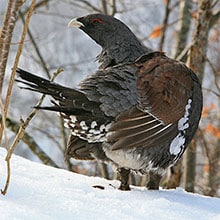 Plumage is made up of the feathers that cover the body of a bird. A feather, meanwhile, is a horny structure that has a tube or barrel embedded in the skin and a shaft that protrudes and displays barbels.
Plumage is made up of the feathers that cover the body of a bird. A feather, meanwhile, is a horny structure that has a tube or barrel embedded in the skin and a shaft that protrudes and displays barbels.
All the feathers of an animal , taken together, make up the plumage. It is important to note that each species has a specific plumage, with different colors, patterns and characteristics in general.
For the bird, plumage is a very important resource since it provides protection against cold and water and helps facilitate its flight . For its part, humans , especially in the field of ornithology , analyze this plumage to recognize the different species and subspecies.
In many cases, the study of plumage also allows us to know if the specimen is going through a disease . It even provides information about their sex and age .
The plumage also fulfills other functions. It can be used for sexual attraction , as a tool for intimidation or as camouflage , to name a few possibilities.
Today, birds are the only animals with feathers; In the past, it is estimated that dinosaurs also had feathers on some parts of their bodies, although they probably did not exhibit full plumage. This difference with the rest of the species is also reflected in the functions performed by their feathers, some of which are mentioned above. Flight is undoubtedly the most characteristic, and they achieve this thanks to the rigidity of those located on their wings, which allow the entire body to be propelled upwards "leaning" on the air.
With respect to body heat, the plumage has various types of feathers, and among them are those that are responsible for thermal regulation. For example, the so-called semi-feathers retain pockets of hot air, whose temperature they can also regulate depending on the time of year and their particular needs. They do this with very characteristic rapid movements, which we can especially appreciate during winter.
Another function related to inclement weather is protection against the wind, which they can stop thanks to the strength of some of their feathers. They also avoid the negative effects of the sun and the accumulation of humidity that rain could bring; They achieve the latter through special feathers that repel water and prevent it from penetrating the rest of the plumage.
 We must not forget that some birds can swim. For this, the plumage is also essential, since they act as small fins that help them propel their body forward. A clear example of this ability occurs in penguins, excellent natural swimmers.
We must not forget that some birds can swim. For this, the plumage is also essential, since they act as small fins that help them propel their body forward. A clear example of this ability occurs in penguins, excellent natural swimmers.
The plumage also serves to allow the bird to float on water , something normally seen in ducks. If the water is cold, then thermal regulation comes into action to counteract the low temperatures. The capercaillie , a galliform bird native to Eastern Europe, has its legs covered with feathers, something that is accentuated in winter to facilitate movement through the snow, since the size of its legs increases.
Typically, birds develop a process known as molting . This implies that, at least once a year, they lose their feathers and replace them with new ones.
Plumage, on the other hand, is the plume that is placed as ornamentation on helmets and hats . In the Roman Empire , for example, soldiers' helmets had different plumages. Thanks to these plumes, it was possible to differentiate between centuries , legions and other military units.
